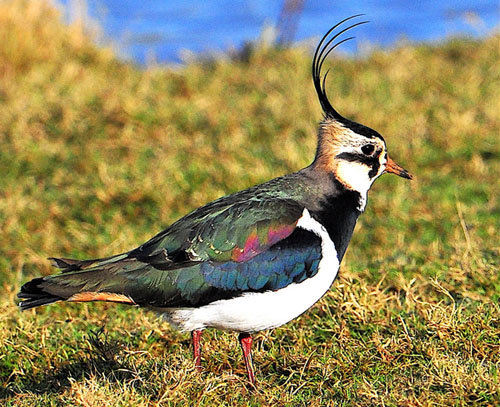
LAPWING (Vanellus vanellus)
(Home)

Lapwings have recently been seen in considerable numbers to the east of the village. George Metcalfe writes:
This much loved bird has long been a familiar resident of most farmed areas of Britain, from the agricultural plains of the south-east to the hills and moors of the north. It is easily identified, with its elegant crest, its apparent black and white plumage (though the black is really a beautiful metallic green, hence its alternative name, green plover) and its broad wings producing what seems a rather laborious flapping flight. It prefers to nest on ploughed land or, in the northern dales, on rough grassy pasture. Like those of other plovers, the young birds leave the nest and start scavenging for food as soon as hatched. In winter, lapwings tend to leave higher ground and migrate to the coast (plovers are essentially waders), where they may be seen in flocks of considerable size, sometimes boosted by visitors from the near continent.
The name “lapwing”, we are told, has nothing to do with its flight, but is of Saxon origin and refers to its crest. Its lovely call, announcing the beginning of spring, is accompanied by the spectacular tumbling display of the male bird. This call has been given a host of local names, all variants on “pee-weet-weet”; peewit, pie-wipe, pee-wee, chewit, tewit, tee-whup…..
For ages and right up to modern times, lapwings were persecuted as food; each year, thousands of eggs were stolen and hundreds of birds netted. This, of course, led to a drastic decline in the birds’ numbers. More recently, there has been a further marked reduction, this time for a number of other reasons, mainly linked to changed farming practices: the loss of mixed farming, increased use of agrochemicals, the switch to autumn cereal sowing and over-stocking of sheep on the hills, for example.
It is sad that, in most parts of Britain including Northamptonshire, it is nowadays rare to see nesting lapwings. We occasionally see flocks of migrating birds in autumn or winter, but how great it would be to see and hear that beautiful spring courtship once more.
Photos: John Sheppard. Text: George Metcalfe.
See Bird Archive for other birds in this series.